Connection Solutions for Modern Wood Buildings
Effective connections provide strength, stiffness, stability and ductility
![]() Continuing Education
Continuing Education
Use the following learning objectives to focus your study while reading this month’s Continuing Education article.
Learning Objectives - After reading this article, you will be able to:
- Describe the basic categories of mechanical and joinery connections for modern wood structures, and their application in both light wood-frame and heavy timber construction.
- Examine the wide range of connection options available today, from traditional joinery methods to widely used fasteners and connectors to the innovative proprietary connection systems that are enabling longer wood spans, higher walls and taller buildings.
- Apply practical and technical design guidance to ensure effective performance of connections in wood structures.
- Discuss key considerations for selection and installation of connections, for best performance and to avoid potential problems
The use of wood as a structural material continues to grow far beyond traditional applications such as single-family homes and buildings up to four stories. Although recent attention has focused on the possibility of wood high-rises, wood's cost-effectiveness, versatility and light carbon footprint are already making it a material of choice for an expanding range of building types—from innovative public, educational and corporate structures that utilize mass timber products as their main architectural expression, to five-story (and higher) multi-family projects built with dimension lumber using long-established techniques. An essential element common to all of these buildings is effective connections.
In wood buildings, effective connections provide strength, stiffness, stability and ductility. They are critical to building performance—under regular loads, and especially during extreme events such as hurricanes and earthquakes. According to post-disaster surveys, structural failures during these events are often due to faults in connection design or assembly.
This continuing education course provides an overview of connection options for modern wood structures, both light wood-frame and heavy timber (see glossary on the next page). It covers mechanical connections—including dowel, shear and metal connector plates with integral teeth—and joinery connections, as well as proprietary connections that are in many ways supporting the current surge in innovative wood design. Proper selection and installation, and ways to avoid potential problems, are also discussed.
Wood Connection Basics
To determine the most appropriate connection for a given application, it is necessary to understand certain fundamentals, starting with the terminology. In this continuing education course, a connection encompasses all of the components that attach one part of a building element to another, be it wood to wood, wood to steel or wood to another material. Within the connection are connectors and/or fasteners. Metal hangers, corner plates, column bases and many other products fall within the category of connectors. Fasteners include (among others) nails, screws, timber rivets and bolts. These products do the ultimate work of fastening the elements of a connection, either with additional connectors (such as hangers) or on their own.
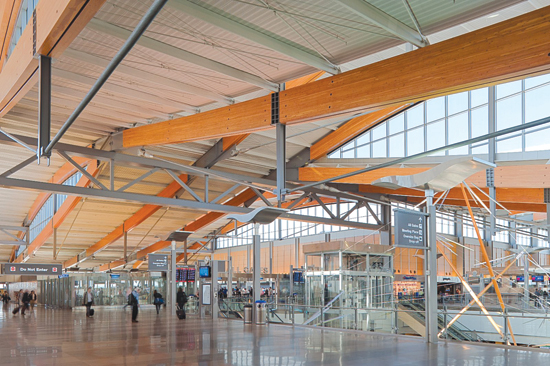
Photo: Nick Merrick © Hedrich Blessing, courtesy of Fentress Architects
Raleigh-Durham International Airport Terminal 2, Fentress Architects
Several characteristics of wood are also relevant to overall connection behavior:
First, wood is anisotropic, meaning it has different strength properties in different directions: longitudinal (strong), tangential (weaker) and radial (weakest).
▶ Wood is stronger in compression and tension parallel to grain versus perpendicular to grain; this is the preferable way of designing wood connections. However, this is not always practical or possible.
▶ While wood is weaker in compression perpendicular to grain, this is the most common way to transfer loads in construction. The most common loads are gravity loads and the typical way to transfer them is in bearing—thus reliance on the compression perpendicular to grain properties of wood. Fasteners are required to transfer other loads, such as wind uplift and the lateral loads caused by occasional wind and seismic forces, into the foundation.
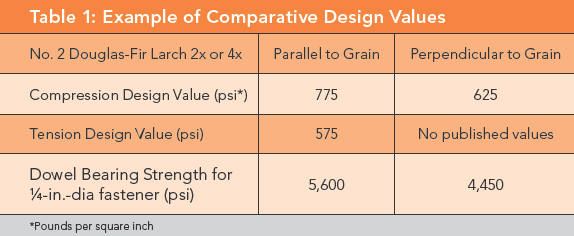
While capacities are more limited when wood is loaded in compression perpendicular to grain (versus parallel to grain), the limits for bearing conditions on the surface of wood members are deformation-based, not strength-based, and published design values can be increased for smaller bearing areas. Accordingly, dowel bearing strengths are higher relative to compression parallel or compression perpendicular to grain values. However, dowel bearing strengths perpendicular to grain are lower relative to dowel bearing strengths parallel to grain for larger diameter (>1/4-in.) fasteners (see Table 1).
▶ Wood is weakest when tension is applied perpendicular to grain. This should be avoided—which is why there are no published design values for tension perpendicular to grain.
Second, wood connections are stronger when the load is spread over a number of fasteners. Large concentrated loads should be avoided unless designed not to exceed the wood's strength capabilities (e.g., net tension and shear). Spreading the load also builds in a degree of redundancy, which is useful in high wind or seismic events. To accomplish this, designers are advised to:
▶ Use small fasteners.
▶ Use multiple fasteners when possible.
▶ Keep the scale of fasteners relative to the size of wood members being connected.
Third, as with other building materials, wood moves in response to environmental conditions. The main driver for this movement in wood is moisture. Allowances must be made to accommodate potential shrinkage and swelling, particularly in connections. (See Moisture Effects on page 4.)
Connection Types
There are two major types of connections used in wood buildings: mechanical and joinery (sometimes referred to as carpentry). Within these categories are many variations, and thus a wide range of options to accommodate virtually any building design.
Mechanical Connections
Mechanical connections used in wood buildings can be classified into three major categories: dowel, metal connector plates with integral teeth, and shear. There are also a number of proprietary connections that combine characteristics of each of these types.

Photos: Simpson Strong-Tie
Metal connector plate with integral teeth
Dowel-type fasteners. Wood members connected with dowel-type fasteners are probably the most common mechanical connection type because they are effective at transferring loads while also being relatively simple and efficient to install. They come in many forms and their strength properties can be calculated using the National Design Specification® (NDS®) for Wood Construction. Nails are generally used when loads are relatively light, as in multi-family and light commercial buildings. Staples can be used in place of nails, but equivalent capacities need to be determined as the NDS doesn't publish design values for staples. Screws may be more satisfactory than nails under certain conditions (such as exposure to moisture) since they have less tendency to work loose and generally have high wind withdrawal resistance under severe wind events. Timber rivets are a high-strength dowel-type fastener used in conjunction with specially fabricated metal plates.
Dowelled connections transfer the force between members through a combination of dowel bearing and bending of the dowel fastener.

Photos: Nic Lehoux; StructureCraft (inset)
At the Arena Stage for the Mead Center for American Theater in Washington, D.C., castings were custom designed for each of the 18 parallel strand lumber column bases.
Project:
Arena Stage at the Mead Center for American Theater
Architect:
Bing Thom Architects
Design-Build:
StructureCraft
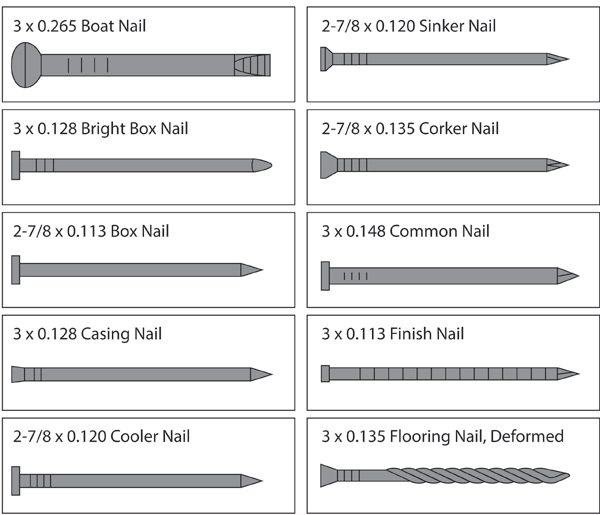
This chart shows 10 nails, all referred to as 10d, and each with potentially different performance characteristics. Thus, specifying a 10d nail is not clear.
▶ Nails come in many types (e.g., box nail, common nail, rink shank, sinker, cooler), as well as multiple pennyweights (the NDS tabulates 6d to 60d). There are also proprietary nails unique to specific manufacturers.
For flooring, APA – The Engineered Wood Association recommends using a glued-nailed system, as described in the Engineered Wood Construction Guide. In this system, glue is used to attach sheathing to the substrate member, whether lumber or an I-joist, to minimize squeaks and increase stiffness due to T-beam action. All nailing must be completed before glue sets. Gluing is not recommended for bonding wall or roof sheathing to framing because it leads to reduced ductility. This approach is actually prohibited in high seismic zones.
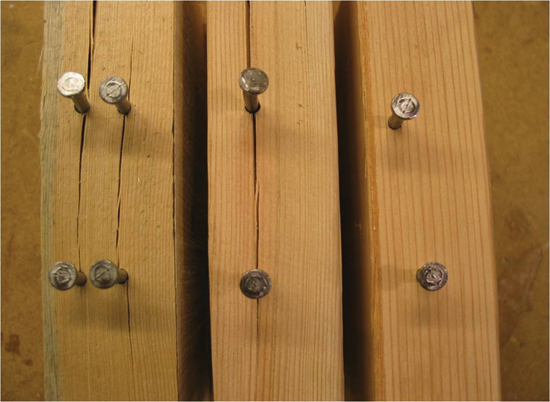
Photo: American Wood Council
Nail spacing is important. If splitting occurs, it will always occur parallel to the grain and not perpendicular to grain, no matter how close the nails are spaced along this axis. Staggering a line of nails when closely spaced, minimizes potential splitting along the length of the member. In a tightly nailed shear wall, staggered nailing helps prevent splitting of framing members and allows higher loads to be transferred.
▶ Bolt design values are tabulated in the NDS for five diameters (1/2 in., 5/8 in., 3/4 in., 7/8 in. and 1 in.). Diameters greater than 1 in. are not permitted as they can initiate localized stresses in the wood member, which can cause splitting or other brittle wood failures. Bolts are inserted in pre-drilled holes 1/32 in. to 1/16 in. larger than the bolt diameter. A common mistake is not leaving enough room for installation of nuts or tightening with a wrench or other torque device.
▶ Lag screws are typically used when it isn't possible to use a nut as required for bolts or when withdrawal capacity is required. They are inserted into pre-drilled holes. The clearance hole for the shank (unthreaded portion of the lag screw) should be the same diameter as the shank, while the lead hole for the threaded portion is a variable percentage of the shank diameter based on the wood's specific gravity. Because lag screws can be fully threaded, the NDS assumes fairly conservative design values which are based on the smaller “root” diameter of the fastener. Higher lateral capacities for lag screws can be calculated if the designer can ensure the threads are far enough from the shear plane. For more information, see the American Wood Council (AWC) publication, Application of Technical Report 12 for Lag Screw Connections, Design Aid No. 1.
▶ Timber rivets are high-strength steel nails typically hot-dipped galvanized, with a flattened oval shank section and a wedge-shaped head. When driven through the pre-drilled steel plate and into the timber, the tapered heads wedge tightly in the holes. Rivets must be driven with the long axis parallel to the wood grain. An excellent way to spread the load with multiple fasteners, they can be used as an alternate to a large number of bolts, resulting in a connection with greater ductility and resilience.

Modern Computer Numerically Controlled (CNC) connections provide the ability to fabricate joints with precision. This is especially useful when fabricating joints on large members with complex shapes.
Metal connector plates with integral teeth partially penetrate the wood members and are used primarily with fabricated lightweight wood trusses. With these connections, loads are transferred near the surface of the wood member.
Shear connectors, sometimes referred to as bearing connectors, are typically used to accommodate heavier loads. They include split rings, shear plates and toothed shear plates. They are usually made from cast iron or light metals, and are capable of transmitting the load relying solely on bearing and shear resistance of the wood in the direction parallel or perpendicular to the grain. They can be used to connect wood to wood members or wood to steel, and may be concealed or visible.
Profiled using special machining tools, split rings are usually fitted in a circular groove on the meeting side of the timber members. The split in the steel rings allows the gap in the ring to close or open if the wood members shrink or swell to ensure that the wood members and split ring remain in contact. A bolt is installed through the center to hold the joint assembly together. In connections with shear plates, grooves must be precision machined with special tools, which recess the wood so the shear plates sit flush with the surface. Typically, shear plates and split ring connections have brittle wood failure modes and should be avoided in structures located in high seismic regions unless the designer employs elastic seismic design.
Proprietary connections. Some of the most innovative connection systems are proprietary—that is, produced exclusively by one manufacturer or designed specifically for one building. This area has seen considerable growth in recent years, with connection systems and products developed for use in larger and more complex buildings being designed to take advantage of wood's economic, aesthetic and environmental benefits.
Custom-fabricated structural framing connections, for instance, provide a single-piece connection between two framing members. They generally consist of bent or welded steel, carrying load from the supported member (through direct bearing) into the supporting member (by hanger flange bearing, fastener shear or a combination of the two).
Pre-engineered metal connectors are commonly used in all types of wood construction. Traditional fasteners like nails, bolts and rivets, as well as generic types of pre-engineered metal connectors such as metal hangers, are reliable and widely used, but have some limitations in large, multi-story buildings that newer proprietary systems are designed to overcome. Newer systems, for example, are often concealed, which makes them fire-resistant if they are sufficiently below the wood surface. They can be designed for use in multiples without reducing the strength of the wood, and they can be designed to be either stiffer or more flexible, depending on the application.
One example of a proprietary product that's becoming widely used—especially in cross laminated timber (CLT) and glulam structures (see sidebar on page 5)—is the self-tapping or self-drilling screw. A number of manufacturers in North America, Europe and Japan produce them with different features and in many shapes and sizes. They have enhanced hardness for higher lateral load capacity, and come in various capacities for different applications. The main advantage is that they can be driven into wood without pilot holes, using a regular handheld power drill. This lessens the risk of mistakes in the field and improves efficiency and reliability.

Photo: Simpson Strong-Tie
Self-drilling screws have a drill-shaped point to cut through substrate and eliminate the need to drill a pilot hole.
Pre-engineered connectors are manufactured by component manufacturers, which have exhaustive catalogues of products that suit various applications. Categories, in addition to the ones previously mentioned, include framing anchors, hold-down devices, straps and ties. Many components are fabricated using formed sheet metal, increasing in thickness as loads increase. Specific nailing and fastening requirements are provided by the manufacturers and must be rigorously followed to develop full connection capacity.
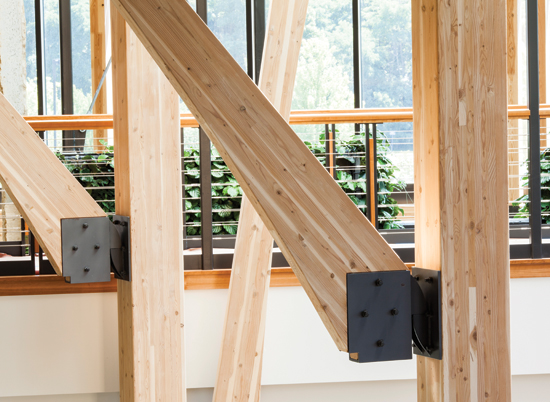
Photo: C&N Photography, courtesy of Uihlein/Wilson Architects
The 52,000-sq-ft client and staff center at the Promega Feynman Center has virtually no square angles, which made beam-to-column connections a challenge. To avoid the need for more than 100 different configurations, a steel pin connector was designed that allows up to 10 degrees rotation in either direction.
Reference design values for mechanical connections are provided in various sources. The NDS contains reference design values for dowel-type connections such as nails, bolts, lag screws, wood screws, split rings, shear plates, drift bolts, drift pins and timber rivets. Design values for proprietary connectors are provided in code evaluation reports.
Joinery
Traditional joinery connections (also known as carpentry connections) are typically created by cutting notches, holes and tongues in connected members so they interlock—such as with mortice/tenon and scarf joints. In these types of connections, forces are in principle transferred in compression/bearing. Interlocked connections in tension require wood or metal pins or keys to prevent separation. Tension connections are often kept to a minimum and in some cases metal straps and bolts are provided to achieve better connections, mainly for long-span roof trusses in historic structures. In a properly designed joinery connection, there is sufficient interlocking, tightening of connections and friction due to the self-weight and supplementary support from walls, buttresses and adjacent buildings to design for both gravity and lateral forces associated with wind or seismic events.
While fairly common in single-story homes, commercial and recreational structures, joinery connections are seldom used for modern, multi-story heavy timber buildings. One reason is the fact that these connection systems demand highly developed skills usually associated only with experienced carpenters. Such connections are also labor intensive which makes them uneconomical for industrial production.
Although joinery parts can be produced with great speed and precision using Computer Numeric Controlled (CNC) technology, this approach is not as widely used in North America as it is in Japan and Western Europe. Here, mechanical connections dominate primarily because they can be made without expensive equipment and assembled with relative ease on site.
Avoiding Potential Problems
Notching
Although notching is an essential technique in traditional joinery, and may be required in the field for a number of reasons, any field notches or holes that are not properly made, or that deviate from approved drawings, may significantly reduce the capacity of even a properly designed member. The NDS provides guidance on notching, and the wood industry has produced extensive technical notes with recommendations related to the size of notches appropriate for different materials. With glulam, for example, end notching is limited to 1/10th the depth of the member or 3 in., whichever is less. When a notch is used, designers should consider driving a lag screw or self-tapping screw in 6-8 in. from the bearing going up past the neutral axis. If a crack were to develop, the screw will keep it from progressing down the length of the beam and acts as a transverse reinforcement.
Moisture Effects
Wood expands and contracts as a result of changes in its equilibrium moisture content (EMC). Expansion in the direction parallel to grain in a wood member is minimal; however, change in the direction perpendicular to grain can be considerable and must be accounted for in connection design and detailing. The common rule-of-thumb is that wood will experience a 1% change in the radial or tangential direction for every 4% change in moisture content. A nominal 2x12, for example, can decrease in depth through shrinkage by just under 1/4 in. as it changes from 18% to 10% EMC. In designing connections, it is important to design and detail the connection such that the member's shrinkage is not restrained. Otherwise, shrinkage of the wood member can cause excessive tension perpendicular-to-grain stresses and splitting may occur. Specific issues related to shrinkage include:
Beam-to-column connections – Continuous full-depth side plates can cause problems because they restrain wood shrinkage and may cause splitting. Solution: Smaller discontinuous side plates transmit forces and allow wood movement.
Beam-to-beam connections – For beam hangers, fasteners placed near the top of the supported beam can restrain wood shrinkage and may cause splitting. Solution: Fasteners placed near the bottom of the supported beam can minimize the effects of shrinkage while top tabs provide lateral restraint.
Beam-to-wall connections – If bolts are placed high on the beam, or high and low, tension perpendicular to grain stresses may cause splitting. Solution: Bolts near the bottom of the beam, preferably with slotted holes, allow for wood shrinkage. (A variety of pre-engineered connections are available with pre-drilled slotted holes.)
Another issue related to moisture is exposed end grain. This can result in checking and possible decay, even in low rainfall climates. Solutions: Redirect water flow around the connection. Use preservative treated wood products. Use end caps and flashing. Allow for air flow and drying—e.g., by detailing drain holes or slots in box-type connectors or maintaining a gap of at least 1/2 in. between wood and concrete or masonry construction.

Photo: Simpson Strong-Tie
Care must be taken when designing steel-plated connections. For solid members, for example, slotted holes in the plates must allow shrinkage to occur and prevent splitting of the member. Note that the NDS provides guidance on spacing of fasteners perpendicular to grain to mitigate shrinkage effects.
Selection and Installation
Ensuring that structural connectors perform as intended involves a number of considerations for both the designer and installer. In the ASD/LRFD Manual, AWC highlights them as follows:
Wood Members
Specific details related to the wood members being connected will have an impact on the capacity of the connection. The following are important considerations regarding the wood members themselves:
▶ The species of wood must be the same as that for which the connector was rated by the manufacturer. Manufacturers test and publish allowable design values only for certain species of wood. For other species, consult with the connector manufacturer.
▶ The wood must not split when the fastener is installed. A fastener that splits the wood will not provide enough capacity for the design load. If wood tends to split, consider pre-boring holes using a diameter not exceeding 3/4 of the nail diameter. Pre-boring requirements for screws and bolts are provided in the NDS.
▶ Regarding shrinkage, most connectors are manufactured to fit common dry lumber dimensions. Other dimensions may be available from the manufacturer.
▶ Where built-up members (multiple members) are installed in a connector, the members must be fastened together prior to installation of the connector so they act as a single unit.
▶ The dimensions of the supporting member must be sufficient to receive the specified fasteners. Most connectors are rated based on full penetration of all specified fasteners. Refer to the connector manufacturer for other situations.
▶ If a connection is designed to transfer load by bearing, the bearing capacity of the wood members should be evaluated.
▶ Local stresses in connections using multiple fasteners should be checked to ensure adequacy. Where a fastener group is composed of closely spaced fasteners loaded parallel to grain, the capacity of the fastener group may be limited by wood failure at the net section or tear-out around the fasteners caused by local stresses.
Connectors
The condition of the connector is critical to how it will perform. The following are important items regarding the connector:
▶ Connectors may not be modified in the field unless noted by the manufacturer. Bending steel in the field may cause fractures at the bend line, and fractured steel will not carry the rated load.
▶ Modified connectors may be available from the manufacturer. Not all modifications are tested by all manufacturers. Contact the manufacturer to verify loads.
▶ In general, all holes in connectors should be filled with the nails specified by the manufacturer. Contact the manufacturer regarding optional nail holes and optional loads.
▶ Different environments can cause corrosion of steel connectors. Always evaluate the environment where the connector will be installed. Connectors are available with different corrosion resistances. Contact the manufacturer for availability.
Fasteners
Most wood connections rely on fasteners to transfer the load from one member to the other. Therefore, the choice and installation of the fasteners is critical to the performance of the connection. The following are important considerations:
▶ All fasteners specified by the manufacturer must be installed in accordance with the manufacturer's installation recommendations to achieve the published value.
▶ The size of fastener specified by the manufacturer must be installed.
▶ The fastener must have at least the same corrosion resistance as the connector.
▶ Bolts must generally be structural quality bolts, equal to or better than ANSI/ASME Standard B18.2.1.
▶ Bolt holes must be a minimum of 1/32 in. and a maximum of 1/16 in. larger than the bolt diameter.
▶ Fasteners must be installed prior to loading the connection.
▶ Power-driven fasteners may deflect and injure the operator or others. Nail tools may be used to install connectors, provided the correct quantity and type of nails are properly installed in the manufacturer's nail holes. Nail tools with nail hole-locating mechanisms should be used. Follow the nail tool manufacturer's instructions and use the appropriate safety equipment.
Design Guidance for Effective Connections
Connections obviously need to provide the structural strength necessary to transfer loads. As discussed above, well-designed connections also mitigate potential adverse effects of moisture ingress. Finally, well-designed connections minimize the potential for excessive tension perpendicular to grain stresses—under design conditions as well as those related to unusual loading conditions. Chapter 10 of the ASD/LRFD Manual provides details for a variety of design configurations (e.g., beam-to-concrete or masonry wall connections and beam-to-beam connections). Many begin with a brief discussion of the pertinent design challenges. For example:

Image: American Wood Council
Beam-to-Concrete or Masonry Wall Connections
Design concept: Concrete is porous and “wicks” moisture. Good detailing never permits wood to be in direct contact with concrete.
A. Beam on shelf in wall. The bearing plate distributes the load and keeps the beam from direct contact with the concrete. Steel angles provide uplift resistance and can also provide some lateral resistance. The end of the beam should not be in direct contact with the concrete wall.
B. Similar to detail A with a steel bearing plate only under the beam.
C. Similar to detail A with slotted holes to accommodate slight lateral movement of the beam under load. This detail is more commonly used when the beam is sloped as opposed to flat.
Five Stories and Higher
With the exception of height, the outward appearance of mid-rise wood-frame buildings has not changed a lot over the years; however, the quality and precision of design and construction has increased considerably. Connection-related design aspects that are more critical in a five- or six-story wood-frame building include accommodating greater dead, live, wind and seismic loads, which increase with the additional height.
Going from four to six floors, for example, increases the gravity loads by 50% but lateral forces due to wind or seismic forces may actually double.
While the size and capacity of connections might change and designers may use more specialized, high-capacity connectors, the connectors themselves are largely the same as they are for any light wood-frame building—nails, bolts and lag screws used with and without proprietary connectors.
Heavy Timber Construction
Heavy timber construction utilizes many of the standard connections described above, including bolted connections, timber rivets, split rings and shear plates. Innovative proprietary connections are also widely used, and today's designers have a tremendous range of options. Innovative examples include, among many others, grid plates, concealed kerf plates with self-drilling dowels and “lagscrewbolts,” which offer the bearing strength of a bolt and a withdrawal strength greater than that of shorter lag screws.
Because heavy timber buildings lend themselves to innovative design, many require custom connections to arrive at the sensitive balance between safety, efficiency, serviceability and aesthetics.
Traditional heavy timber details are available in the publications, Heavy Timber Construction Details by AWC and Glulam Construction Details (Form T300) by APA – The Engineered Wood Association. These details are consistent with the construction requirements outlined in IBC section 2304.10. They are representative of those you would find in existing historic buildings, and are useful when retrofitting or restoring historic structures.
 |
The reThink Wood initiative is a coalition of interests representing North America’s wood products industry and related stakeholders. The coalition shares a passion for wood products and the forests they come from. Innovative new technologies and building systems have enabled longer wood spans, taller walls and higher buildings, and continue to expand the possibilities for wood use in construction. www.rethinkwood.com |

